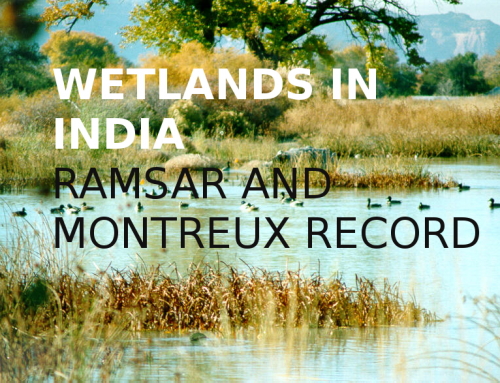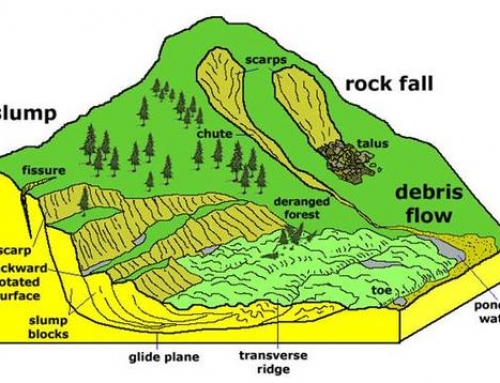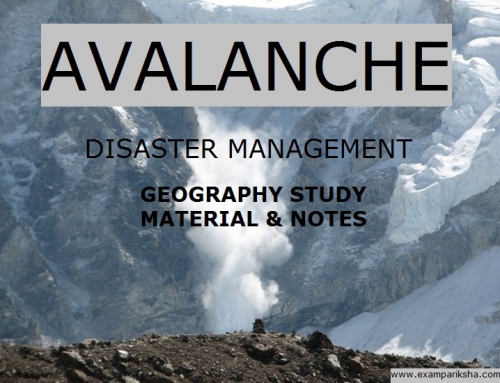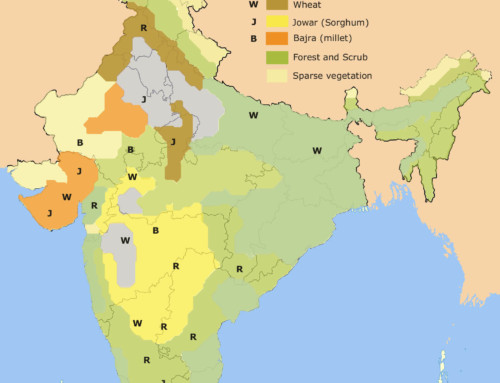Air in horizontal motion is Wind, And Atmospheric Pressure determines the rise and sink of air. The pressure and winds in atmosphere determine formation of air masses and occurrence of storms.
Atmospheric pressure – Weight of air column contained in a unit area from mean sea level to the top of atmosphere is known as Atmospheric pressure. It is measured in force per unit area. It is expressed in ‘milibar’/mb unit. For practical purposes, the atmospheric pressure is expressed in kilo-pascals.
Due to gravity, air at surface is denser and has higher air pressure. It is measured by the mercury barometer or aneroid barometer.In lower atmosphere, pressure decreases rapidly with height. At sea level, average atmospheric pressure is 1,013.2 milibar.
Wind – When air moves from high pressure areas to low pressure areas.
Vertical pressure gradient force is much larger than the horizontal pressure gradient. But we don’t feel strong upward winds because vertical gradient is balanced by gravitational force. Horizontal distribution of pressure is studied by drawing isobars at constant levels.
<< Read about the Federal structure of Indian Constitution here>>
World distribution of Atmospheric Pressure:
The following pressure belts oscillate with the apparent movement of sun. In northern hemisphere in winter, they move southwards and in summers northwards.
- Equatorial low – It occurs near the equator the sea level pressure is low.
- Subtropical high – Along the 30 degrees North and 30 degrees South, there are high pressure areas.
- Sub-polar Lows – Along 60 degrees North and 60 degrees South, low pressure belts.
- Polar Highs – It occurs near poles, the pressure is high.
Factors affecting velocity and direction of Wind in Atmosphere:
Air motion due to differences in atmospheric pressure is known as Wind. From high pressure to low pressure. At sphere, wind gets friction due to pressure gradient force – Coriolis force and gravity.
I. Pressure Gradient Force :
- Difference in atmosphere pressure produces a force.
- The rate of change of pressure with respect to distance is known as pressure gradient.
- It is strong where isobars are close to each other and vice-verse.
II. Frictional Force :
- Affects speed of wind.
- The greatest at surface and influences till 1 to 2 km.
- Over the sea, it is minimal.
III. Coriolis Force :
- Force exerted by rotation of Earth is known as Coriolis force.
- French physicist had described it in 1844.
- It deflects the wind to right direction in Northern hemisphere and to left direction in Southern hemisphere.
- More deflection when wind velocity is high.
- Coriolis force is directly proportional to the angle of latitude. Hence, it is maximum at poles and minimum(absent) at equator.
- It acts perpendicular to pressure gradient force. The pressure gradient force is perpendicular to isobars.
- As a result of these two forces operating perpendicular to each other, in the low-pressure area the wind blows around it.
- At equator, the Coriolis force is zero and wind blows perpendicular to isobars. The low pressure gets filled instead of getting intensified. Thats why tropical cyclones are not formed near the equator.
<< Read about the Mauryan Empire in Indian History>>
IV. Pressure and Wind in Atmosphere :
- When pressure and winds in atmosphere have different velocity and direction, net wind generating force come to work.
- The winds above 2 to 3 km from surface are free from frictional effect of surface and controlled by pressure gradient and Coriolis force.
- When isobars are straight and no frictional force acts then – Coriolis force balances pressure gradient force and resultant wind blows parallel to isobars, known as Geo-strophic winds.
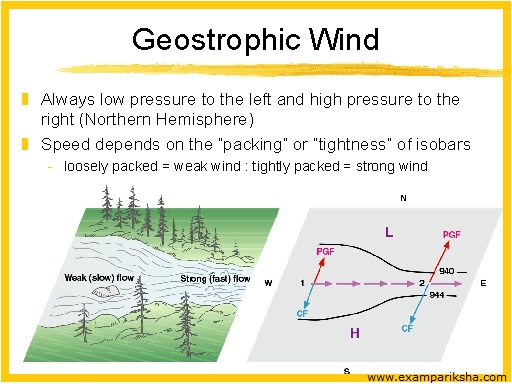
- Wind circulation around a low is called cyclonic circulation, while wind circulation around a high is known as anti-cyclonic circulation.
- Rising of air is essential for cloud formation & precipitation, it is caused not only by Convergence but also by some eddies, uplift along fronts, orographic uplift, convection currents. For cloud formation and precipitation.
General Circulation of Atmosphere
The Pattern of planetary pressure and winds in atmosphere, depends upon the following:
- The latitudinal variation of atmospheric heating
- Emergence of pressure belts
- migration of belts following apparent path of Sun.
- Distribution of continents and oceans.
- Rotation of Earth.
This Pattern of movement of planetary winds is called General circulation of atmosphere. It sets in motion the ocean water circulation which influences the Earth’s climate. The following diagram explains the patterns of atmosphere circulation very clearly.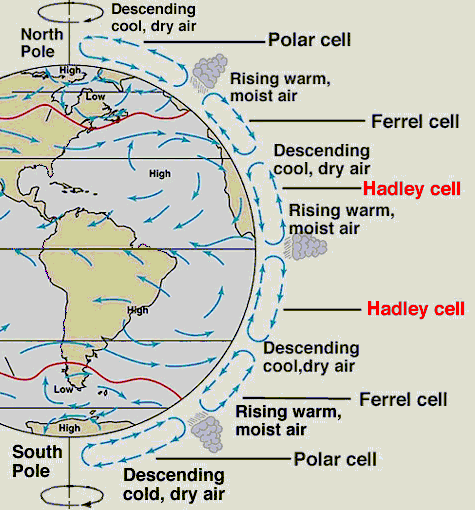
I. Inter Tropical Convergence Zone (ITCZ) at equator. Zone of low atmosphereic pressure and ascending air. Rising air currents are due to global wind convergence and convection from thermal heating(which causes low pressure). The converged air rises along with convective cell and reachs upto 14 km. Then it moves towards poles. This accumulates air around 30 degrees North and South.
<< Read list of Bharat Ratna Award winners in India till now here >>
II. Subtropical highs – The part of accumulated air sinks to ground to form subtropical high. The air sinks because it gets cooled down when it reaches 30 degrees North and South.
III. Easterlies(come from east) – Near land surface, air flows towards the equator, this is known as easterlies. These Easterlies converge from North and South at equator at ITCZ. This forms the Hadley cell in tropics. 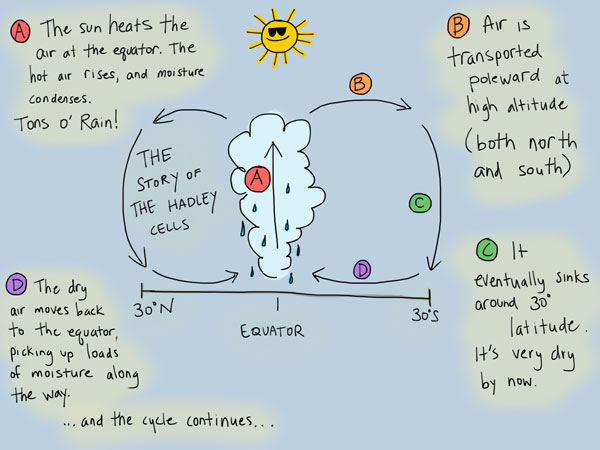
IV. Westerlies – Middle lattitudes the circulation of sinking cold air from poles and rising warm air blows from subtropical high are called westerlies. This cell is called Ferrel Cell.
V. Polar Cell – At poles latitudes the cold dense air subsidies near poles and blows towards middle lattitudes as polar easterlies.
- The Hadley cell, Ferrel cell and Polar cell set pattern for general circulation of atmosphere.
- Heat transfer from lower latitude to higher latitude maintains it.
Effect of General atmospheric circulation on Oceans:
Pacific ocean is most important in general atmospheric circulation terms. Warm water of central pacific slowly drifts towards South American Coast and replaces the cool Peruvian current.
- Appearance of warm current off the coast of Peru – El nino.
- Closely associated with pressure changes in Central Pacific and Australia.
This change in pressure condition over Pacific is known as Southern Oscillation. The combined effect of both these is known as ENSO. When ENSO is strong, that year large scale variations are seen in weather around the world.
<< Read about the provisions of Kisan Vikas Patra here >>
We hope this short compilation for quick revision of Pressure and winds in atmosphere is useful for aspirants. If you want us to make any further additions to the article, please feel free to mention them in the comments below.


